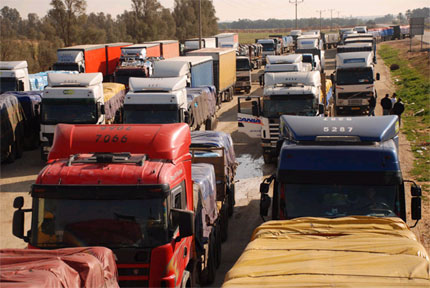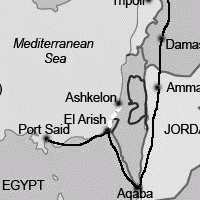Published: may 25, 2010.
A publication of the Israeli Ministry of Foreign Affairs.

IDF coordinates the transfer of truckloads of humanitarian aid on a daily basis. (Archive Photo: IDF Spokesperson)
Despite attacks by Hamas, Israel maintains an ongoing humanitarian corridor for the transfer of food and humanitarian supplies to Gaza, used by internationally recognized organizations including the United Nations and the Red Cross.
Humanitarian aid despite Hamas attacks
Despite attacks by Hamas, Israel maintains an ongoing humanitarian corridor for the transfer of perishable and staple food items to Gaza. This conduit is used by internationally recognized organizations including the United Nations and the Red Cross.
Well over a million tons of humanitarian supplies entered Gaza from Israel over the last 18 months equaling nearly a ton of aid for every man, woman and child in Gaza. Millions of dollars worth of international food aid continually flows through the Israeli humanitarian apparatus, ensuring that there is no food shortage in Gaza.
Food and supplies are shipped from Israel to Gaza six days a week. These items were channeled through aid organizations or via Gaza’s private sector.
Large quantities of essential food items like baby formula, wheat, meat, dairy products and other perishables are transferred daily and weekly to Gaza. Fertilizers that cannot be used to make explosives are shipped into the Strip regularly, as are potato seeds, eggs for reproduction, bees, and equipment for the flower industry.
In 2009 alone, more than 738,000 tons of food and supplies entered Gaza. Pictures in local newspapers show local markets aplenty with fruit, vegetables, cheese, spices, bread and meat to feed 1.4 million Gazans.
In the first quarter of 2010 (January-March), 94,500 tons of supplies were transferred in 3,676 trucks to the Strip: 48,000 tons of food products; 40,000 tons of wheat; 2,760 tons of rice; 1,987 tons of clothes and footwear; 553 tons of milk powder and baby food.
In a typical week the IDF coordinates the transfer of hundreds of trucks containing about 15,000 tons of supplies. During the week of May 18, 2010 there were more than 100 truckloads of animal food, 65 trucks of fruit and vegetables; 22 truckloads of sugar, some 27 truckloads of meat, poultry and fish; and 40 trucks of dairy products. At holiday times, Israel increases transfers. During the Muslim holy days of Ramadhan and Eid al-Adha, Israel shipped some 11,000 heads of cattle into the Strip.
Maintaining medical aid for all in need
The medical corridor
No Palestinian is denied medical care in Israel. However, if the Hamas regime does not grant permits for medical care, the Israeli government can do nothing to help the patient. Israel will facilitate all cases of medical treatments from Gaza, unless the patient is a known perpetrator of terror.
Israel maintains a corridor for the transfer of medical patients out of Gaza, and about 200 medical staff members go through the crossings every month. Israel also helps coordinate the transfer of Jordanian doctors into Gaza.
In 2009 alone, 10,544 patients and their companions left the Gaza Strip for medical treatment in Israel. Moreover, there were 382 emergency evacuations from Gaza for medical purposes.
The Hadassah Medical Organization in Jerusalem donates $3 million in aid annually to treat Palestinians in Israel. Following fears of a swine flu outbreak, three Israeli hospitals were assigned to treat cases in the Gaza Strip and 44,500 immunizations were transferred to the Strip.
Since 2005, Palestinians exploited medical care arrangements more than 20 times to carry out terror attacks.
Medical equipment
In 2009, some 4,883 tons of medical equipment and medicine were brought in.
In the first quarter of 2010, Israel shipped 152 trucks of medical supplies and equipment into Gaza. In a typical week (in May 2010), some 37 truckloads of hygiene products were shipped to Gaza through the land crossings. In addition, a new CAT scan machine was recently shipped to Gaza.
In 2009, Israel coordinated the transfer of medical supplies for the disabled including wheelchairs, crutches and first aid kits. Other equipment shipped to Gaza include heart-monitors, baby feeding tubes, dental equipment, medical books, ambulance emergency equipment, artificial limbs and infant sleeping bags.
Building for the future: Infrastructure and economic aid
Building materials
While the import of cement and iron has been restricted into Gaza since these are used by the Hamas to cast rockets and bunkers, monitored imports of truckloads of cement, iron, and building supplies such as wood and windows are regularly coordinated with international parties. Already in the first quarter of 2010, 23 tons of iron and 25 tons of cement were transferred to the Gaza Strip.
On 13 May 2010, Israel allowed approximately 39 tons of building material into Gaza to help rebuild a damaged hospital. The construction material for al Quds hospital was transferred after safeguards in place and French assurances ensured that the construction material would not be diverted elsewhere.
On 24 May 2010 Israel opened the Kerem Shalom crossing to 97 trucks loaded with aid and goods, including six trucks holding 250 tons of cement and one truck loaded with five tons of iron for projects executed and operated by UNRWA.
Electricity
According to the UN report of May 2010, 120 megawatts (over 70%) of the Strip’s electricity supply comes from the Israeli electric grid, while 17 MWs come from Egypt and 30 MWs are produced by the Gaza city power station. Since January 2010, there has been deterioration in the supply of electricity to the Gaza Strip since the Hamas regime is unwilling to purchase the fuel to run the Gaza City power station.
Throughout 2009 Israel transferred 41 trucks of equipment for the maintenance of Gaza’s electricity grid.
Israel facilitates the transfer of fuel through the border, and maintains that the diversion of fuel from domestic power generators to other uses is wholly a Hamas decision. Over 133 million liters of fuel entered Gaza from Israel over the last 18 months.
Sewage
During the first quarter of 2010, the UN coordinated with Israel the transfer of equipment for UNWRA to upgrade the sewage pumping station. In 2009, 127 trucks containing more than 3,000 tons of hypochlorite entered the Gaza Strip for water purification purposes. Moreover, 48 trucks of equipment for improving the sanitation infrastructure led to a substantial reduction in the Beit Lahya facility’s waste levels.
Economy
The United States, Israel, Canada, and the European Union have frozen funds to the Palestinian Hamas government since 2006, recognizing it as a terror organization. Israel has taken measures to support trade and commerce, the banking system, and the existing financial market in the Gaza Strip.
Gazans produce much of their own food products including olives, citrus, vegetables, Halal beef, and dairy products. Primary exports from Gaza are cut flowers and citrus, with trade partners being Israel, Egypt and the West Bank. During 2009, 7.5 million tons of flowers and 54 tons of strawberries were exported from Gaza with Israeli cooperation.
In 2009, 1.1 billion shekels (about $250 million) were transferred to the Gaza Strip for the ongoing activity of international organizations and to pay the salaries of Palestinian Authority workers. 40 million damaged bank notes were traded for new bills, and at the request of the Palestinian Monetary Fund, 282.5 million shekels were transferred from Gazan to Israeli banks.
In February 2010, an agreement was reached with the Palestinian Authority’s National Insurance Department to ensure that pensions reached those formerly employed in Israel. The funds were deposited in banks in Judea and Samaria, while the Palestinian Authority was given the responsibility of distributing the funds to the pensioners in Gaza.
Fostering hope and trust – Quality of life in Gaza
The cycle of life
- Projected life expectancy in the Gaza Strip (2010) is 73.86, greater than Estonia, Malaysia, Jamaica and Bulgaria.
- The infant mortality rate in Gaza is 17.71 per 1000, lower than that of China, Jordan, Lebanon and Thailand.
- Fertility rates are about five children per family, equal to many African nations such as Rwanda and Senegal.
Healthcare
Palestinian families receive the same subsidized healthcare as Israelis, about 10% of the cost for the same treatment in the United States.
Schoolchildren
Israel transfers school equipment supplied by UNRWA including notebooks, school bags, writing implements and textbooks. Israel is currently coordinating the transfer of 200,000 laptops for Gaza schoolchildren and the shipment of 74 maritime containers for conversion into Gaza classrooms.
In the first quarter of 2010, Israel transferred 250 trucks with equipment for the UNWRA summer camp, including arts-and-crafts equipment, swimming pools, inflatable toys, ice cream machines, musical instruments, clothing, sports equipment.
Electronic life
About 20% of the population in Gaza owns a personal computer – this is more than Portugal, Brazil, Saudi Arabia or Russia. They have access to ADSL and dial-up Internet service, provided by one of four providers.
About 70% of Gazans own a TV and radio and have access to satellite TV or broadcast TV from the PA or Israel.
Gaza has well-developed telephone landlines, and extensive mobile telephone services provided by PalTel (Jawwal) and the Israeli provider Cellcom.
According to USAID report, 81% of households in Gaza have access to a cell phone. The PA-owned cell phone provider Jawwal has more than 1 million cellular subscribers.
Travel
Despite the inherent dangers involved, Israel permits Gazans and visitors to travel between Gaza and Israel, from Gaza to Judea and Samaria (the West Bank), and even abroad for medical treatment, religious pilgrimages, and business trips. Whenever possible Israel allows for diplomatic activities and trade and commerce with the Gaza Strip.
In additional to medical travel, 21,200 activists from international organizations and over 400 diplomatic delegations were permitted entry into Gaza, while 2,200 Palestinians employed by international organizations were given exit permits from the Gaza Strip.
147 permits were given to Palestinian students for academic studies around the world and special permission was given to Gazan footballers to train in Judea and Samaria and compete in international matches abroad.
During the Christmas holiday, approximately 400 permits were given to visit Bethlehem from Gaza as well 100 permits to travel abroad. In addition, 257 permits were given to businessmen from Gaza to facilitate business operations.



 RSS
RSS











The Israeli Humanitarian Lifeline to Gaza | Middle East Affairs …: According to USAID report, 81% of households … http://bit.ly/crSXkO
[…] article on the MFA website, entitled “Behind the Headlines: The Israeli humanitarian lifeline to Gaza,” begins with this […]
The Israeli Humanitarian Lifeline to Gaza #israel #gaza #aid http://j.mp/b0yxeA
RT @CrethiPlethi: The Israeli Humanitarian Lifeline to Gaza #israel #gaza #aid http://j.mp/b0yxeA
[…] This post was mentioned on Twitter by Elisabeth and Crethi Plethi, Inside USAID. Inside USAID said: The Israeli Humanitarian Lifeline to Gaza | Middle East Affairs …: According to USAID report, 81% of households … http://bit.ly/crSXkO […]
Claims that Israelis refuse medical supplies & wheelchairs to Gazans appear to be unfounded: http://j.mp/dvYL5M #tcot #ocra #sgp
RT @s_dog: Claims that Israelis refuse medical supplies & wheelchairs to Gazans appear to be unfounded: http://j.mp/dvYL5M #tcot #ocra #sgp
RT @s_dog: Claims that Israelis refuse medical supplies & wheelchairs to Gazans appear to be unfounded: http://j.mp/dvYL5M #tcot #ocra #sgp
RT @s_dog: Claims that Israelis refuse medical supplies & wheelchairs to Gazans appear to be unfounded: http://j.mp/dvYL5M #tcot #ocra #sgp
RT @s_dog: Claims that Israelis refuse medical supplies & wheelchairs to Gazans appear to be unfounded: http://j.mp/dvYL5M #tcot #ocra #sgp
[…] materiel cannot. And we do let civilian goods into Gaza. There is no humanitarian crisis in Gaza. Each week, an average of ten thousand tons of goods enter Gaza. There’s no shortage of food. There’s no shortage of medicine. There’s no shortage […]
[…] boats heading for Gaza will be unloaded in Ashdod and shipped to Gaza by truck along with the other aid sent through Israel, officials […]